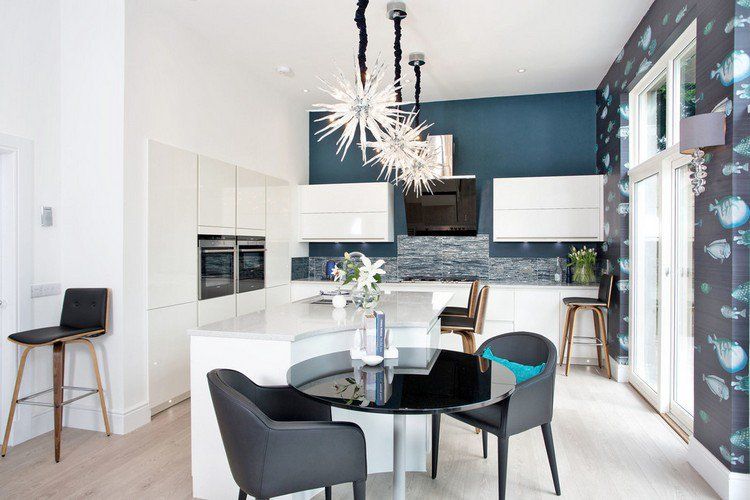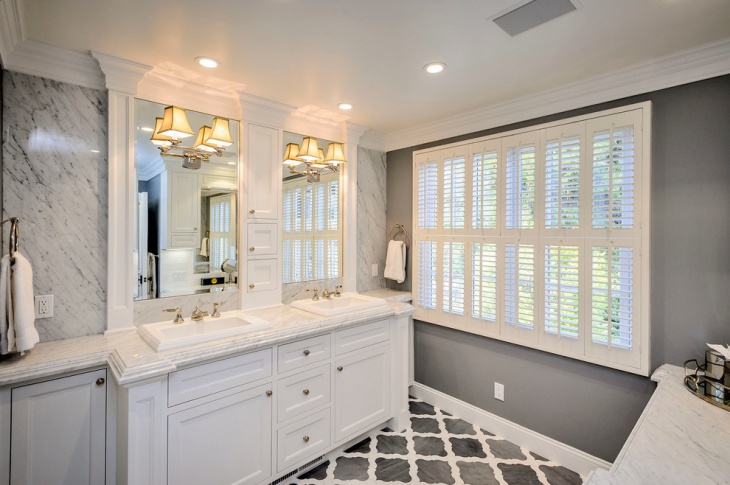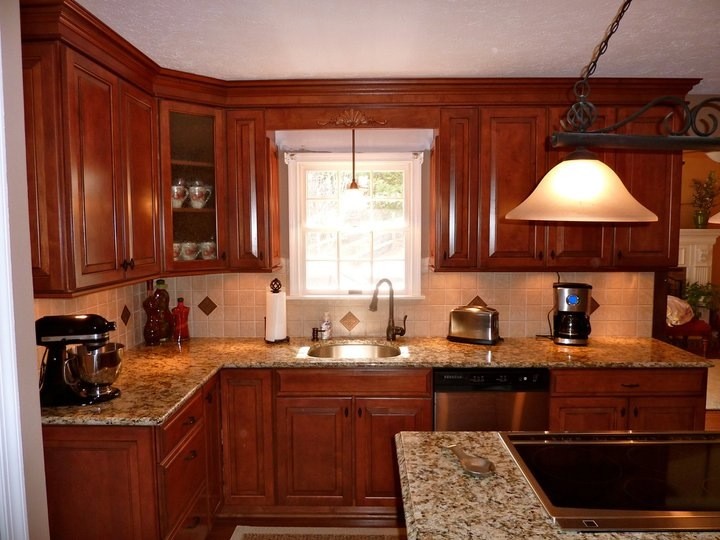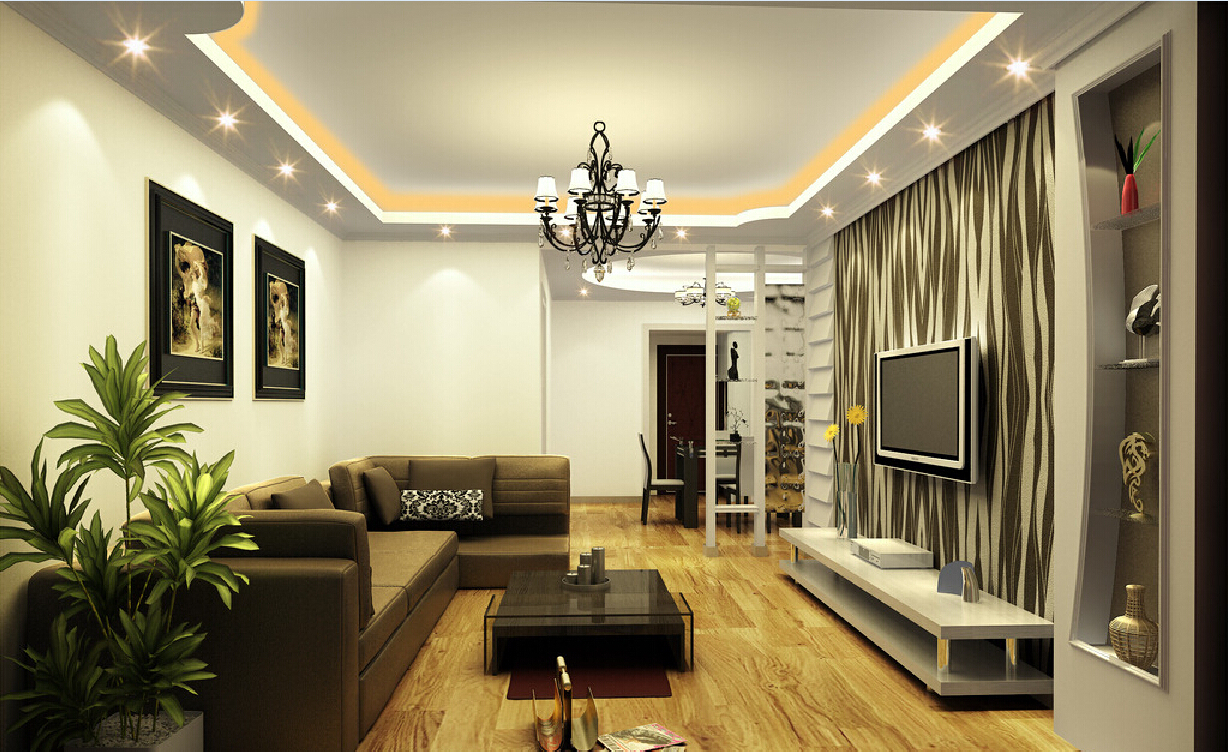Farmhouse kitchen design motifs bring a subtle rustic comfort to space while maintaining a modern elegance. In a farmhouse kitchen, you will usually see furniture pieces made from natural materials like wood and stone. Cabinetry often features shaker-style doors and distressed finishes, with lighting fixtures that feature matte finishes in black or bronze and vintage-inspired shapes. A classic farmhouse kitchen design also includes a large apron-front sink, pendant lighting or glass globes, and a mixture of rustic and modern elements.Farmhouse
Modern kitchen design motifs feature minimalistic, sleek styling and clean lines. They usually incorporate natural materials such as wood and stone, and often focus on functionality over aesthetic. Cabinetry in modern kitchen design motifs typically have finish with flat fronts or handles with clean, crisp lines. Lighting fixtures can be simple and understated but with a nod to technological elements, such as geometric shapes, recessed lighting, and LED bulbs. Additionally, modern kitchen designs often feature gender-neutral designs and colors, such as stone, white, gray, and black.Modern
Rustic kitchen design motifs are inspired by country settings. This can incorporate features such as furniture pieces with hand-hewn, distressed finishes, cabinetry with aged patina, and vintage-inspired light fixtures. Rustic kitchen designs also typically incorporate natural elements, such as stone countertops and wooden floors. Additionally, traditional materials such as brick and masonry play an important role in rustic kitchen motifs. The overall effect should be natural, warm, and comfy, without losing the touch of modern style.Rustic
Transitional kitchen design motifs incorporate the best of both modern and traditional kitchens. They are a blend of materials that lend a timeless, uncomplicated feel. Transitional kitchen designs often use soothing colors, like grays and neutrals, to create an atmosphere of serenity and peace. They incorporate elements like painted cabinets, streamlined hardware, and accents in different finishes to tie everything together. Transitional kitchen designs also typically feature a combination of flooring materials, such as hardwood and stone, which are blended but separate. Transitional
Traditional kitchen design motifs often incorporate elements of classic designs with features from the turn of the century. Typical traditional kitchen elements include built-in seating, furniture pieces with curved lines and details, as well as carved wooden cabinetry. These kitchens make use of traditional materials, such as hardwood flooring and stone countertops, and they often feature old-fashioned farmhouse sinks. Classic metals, like copper and brass, are usually used for fixtures and accents, along with antiques and period-style lighting.Traditional
Contemporary kitchen design motifs feature clean lines and streamlined shapes, often using bright colors and unique materials. These kitchens typically make use of stainless steel appliances, contemporary cabinetry designs, futuristic light fixtures, and granite countertops to create a modern and high-tech look. The colors used are usually white, black, or neutral shades like gray, and the desired effect is one of a polished yet functional kitchen. Contemporary
Scandinavian kitchen design motifs feature bright, clean spaces paired with a touch of natural wood. These kitchens are often filled with natural materials, such as cork flooring and stone countertops, as well as cabinetry in soft, minimalistic shades like white and gray. Accents of blue and green can also be found in this style, as well as traditional Scandinavian furniture pieces. Additionally, unique lighting fixtures, like pendant lights and sleek track lighting, contribute a modern touch. Scandinavian
Industrial kitchen design motifs draw on elements of steampunk, vintage, and utilitarian appeal. This style of kitchen usually incorporates a combination of sleek metal and warm, natural materials. Cabinetry can be made of materials such as stainless steel or natural wood, and may feature open shelving or industrial details like exposed screws or pipe accents. Industrial lighting fixtures with exposed Edison bulbs and high-end appliances with clean lines are also often present in this type of kitchen design. Industrial
Minimalist kitchen design motifs incorporate sleek designs that prioritize function over form. These kitchens typically have fewer furnishings in neutral colors, and the cabinetry is usually recessed to create a streamlined look. Appliances are often integrated to create an open, airy, and uncluttered atmosphere. Additionally, these kitchens are equipped with modern, sleek hardware, and fixtures that are both subtle and functional. Minimalist kitchen motifs are perfect for sleek, modern spaces that want to emphasize their openness and clarity. Minimalist
Bohemian kitchen design motifs draw inspiration from cultures around the world. They incorporate materials with unique textures and colors, such as terracotta, rustic wood, and woven fabrics. Cabinetry can feature designs that are custom-made, vintage, or handcrafted. Bold and vibrant colors are used in accents, while metal and stone surfaces offer a modern touch. Additionally, unique lighting fixtures, such as pendant lights and wall sconces, add to the eclectic vibe of this style. Bohemian
Kitchen design motifs can range from traditional and classic to modern and industrial. These styles all draw on traditional elements, but have a unique take on them that gives each style its own character. Farmhouse, modern, rustic, transitional, traditional, contemporary, Scandinavian, industrial, minimalist, and bohemian are all popular motifs that can be integrated into kitchen design. No matter which motif is chosen, each kitchen should be tailored to the individual's style and purpose.PRIMARY_Kitchen Design Motifs
Kitchen Design Motifs for Home Aesthetics
 The
kitchen
is the focal point of every home. It sets the tone for the entire household, and the right
design
motifs can add beauty and functionality to even the most challenging of spaces. Whether you are looking to create a contemporary kitchen, or something more traditional, selecting the right combination of elements is key to achieving a flourishing, cohesive end design.
The
kitchen
is the focal point of every home. It sets the tone for the entire household, and the right
design
motifs can add beauty and functionality to even the most challenging of spaces. Whether you are looking to create a contemporary kitchen, or something more traditional, selecting the right combination of elements is key to achieving a flourishing, cohesive end design.
Colours & Composition
 When it comes to creating a winning design, colours are truly the workhorses of the operation. Oftentimes, the best designs will match cool and warm colours together, creating an inviting atmosphere. Cool hues of grey, blue, and green are perfect against warm taupes, browns, and creams for the perfect balance.
When it comes to creating a winning design, colours are truly the workhorses of the operation. Oftentimes, the best designs will match cool and warm colours together, creating an inviting atmosphere. Cool hues of grey, blue, and green are perfect against warm taupes, browns, and creams for the perfect balance.
Accessories
 When accomplishing a design, accessories truly play a vital role. Whether adding open shelving, lighting, or artwork, accessories can completely transform an ordinary kitchen into a work of art. To add sparkle and texture, consider adding tiles in shades and patterns chosen to complement other kitchen elements.
When accomplishing a design, accessories truly play a vital role. Whether adding open shelving, lighting, or artwork, accessories can completely transform an ordinary kitchen into a work of art. To add sparkle and texture, consider adding tiles in shades and patterns chosen to complement other kitchen elements.
Layout
 The
layout
of a kitchen is just as important as the furniture and accessories it contains. When planning for a kitchen layout, it is necessary to consider how space is used and who will be utilizing it. Attention should be given to the features and appliances that are most important to you, as well as the amount of storage needed for the tasks to be completed. With proper planning, the right layout can increase efficiency and simplify tasks in the kitchen.
The
layout
of a kitchen is just as important as the furniture and accessories it contains. When planning for a kitchen layout, it is necessary to consider how space is used and who will be utilizing it. Attention should be given to the features and appliances that are most important to you, as well as the amount of storage needed for the tasks to be completed. With proper planning, the right layout can increase efficiency and simplify tasks in the kitchen.
Materials
 The
materials
a kitchen is outfitted with are essential to creating the perfect aesthetic. Materials, such as counter tops, cabinets, and floors should all reflect the desired design motif. For example, if the home is traditional in theme, granite counter tops or marble floors are ideal, while a contemporary home may require sleek stainless steel appliances to complete the look.
From colours and accessories to layout and materials, the right motifs can turn an ordinary kitchen into a haven of beauty and efficiency. With careful planning and attention to details, your kitchen will be an inviting, inspiring place to create and share.
The
materials
a kitchen is outfitted with are essential to creating the perfect aesthetic. Materials, such as counter tops, cabinets, and floors should all reflect the desired design motif. For example, if the home is traditional in theme, granite counter tops or marble floors are ideal, while a contemporary home may require sleek stainless steel appliances to complete the look.
From colours and accessories to layout and materials, the right motifs can turn an ordinary kitchen into a haven of beauty and efficiency. With careful planning and attention to details, your kitchen will be an inviting, inspiring place to create and share.



































































































